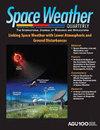解析行星际CME模型的一系列进展
IF 3.8
2区 地球科学
Q2 ASTRONOMY & ASTROPHYSICS
Space Weather-The International Journal of Research and Applications
Pub Date : 2023-10-31
DOI:10.1029/2023sw003647
引用次数: 0
摘要
日冕物质抛射(cme)和高速流(hss)是一种大规模的瞬态结构,通常会从太阳向外传播。单独来说,它们可以在地球或太空中的其他地方造成空间天气影响,但当这些结构在星际传播过程中相互作用时,就会发生许多最大的事件。我们提出了开放太阳物理快速集合信息(OSPREI)的初始耦合,一个CME演化模型,与高速流的主要经验操作风,一个时间相关的HSS模型,可以作为OSPREI CME的背景。为了利用新的时间相关的高维背景,我们提出了对OSPREI进行的几项改进。这包括在拖动计算中的更新和确定偏航角旋转的能力。我们提出了几个理论案例研究,描述了在HSS背景和静止背景下CME行为的差异。这种行为包括行星际抛射的传播、膨胀、变形和旋转,以及抛射驱动鞘层的形成。我们还确定了CME的行为如何随着HSS大小和初始锋面距离的变化而变化。一般来说,对于一个快速日冕抛射,我们看到在高通量内的阻力大大减少,导致日冕抛射更快,旅行时间更短。如果日冕物质抛射到达流相互作用区域或上游太阳风,阻力会再次变得更强,导致更强的激波和更多的压缩,直到日冕物质抛射充分减速。我们模拟了帕克太阳探测器在2022年1月观测到的CME-HSS相互作用事件。模型的改进使其与观测到的原位剖面更好地匹配。本文章由计算机程序翻译,如有差异,请以英文原文为准。
A Series of Advances in Analytic Interplanetary CME Modeling
Abstract Coronal mass ejections (CMEs) and high speed streams (HSSs) are large‐scale transient structures that routinely propagate away from the Sun. Individually, they can cause space weather effects at the Earth, or elsewhere in space, but many of the largest events occur when these structures interact during their interplanetary propagation. We present the initial coupling of Open Solar Physics Rapid Ensemble Information (OSPREI), a model for CME evolution, with Mostly Empirical Operational Wind with a High Speed Stream, a time‐dependent HSS model that can serve as a background for the OSPREI CME. We present several improvements made to OSPREI in order to take advantage of the new time‐dependent, higher‐dimension background. This includes an update in the drag calculation and the ability to determine the rotation of a yaw‐like angle. We present several theoretical case studies, describing the difference in the CME behavior between a HSS background and a quiescent one. This behavior includes interplanetary CME propagation, expansion, deformation, and rotation, as well as the formation of a CME‐driven sheath. We also determine how the CME behavior changes with the HSS size and initial front distance. Generally, for a fast CME, we see that the drag is greatly reduced within the HSS, leading to faster CMEs and shorter travel times. The drag reappears stronger if the CME reaches the stream interaction region or upstream solar wind, leading to a stronger shock with more compression until the CME sufficiently decelerates. We model a CME–HSS interaction event observed by Parker Solar Probe in January 2022. The model improvements create a better match to the observed in situ profiles.
求助全文
通过发布文献求助,成功后即可免费获取论文全文。
去求助
来源期刊
CiteScore
5.90
自引率
29.70%
发文量
166
审稿时长
>12 weeks
期刊介绍:
Space Weather: The International Journal of Research and Applications (SWE) is devoted to understanding and forecasting space weather. The scope of understanding and forecasting includes: origins, propagation and interactions of solar-produced processes within geospace; interactions in Earth’s space-atmosphere interface region produced by disturbances from above and below; influences of cosmic rays on humans, hardware, and signals; and comparisons of these types of interactions and influences with the atmospheres of neighboring planets and Earth’s moon. Manuscripts should emphasize impacts on technical systems including telecommunications, transportation, electric power, satellite navigation, avionics/spacecraft design and operations, human spaceflight, and other systems. Manuscripts that describe models or space environment climatology should clearly state how the results can be applied.

 求助内容:
求助内容: 应助结果提醒方式:
应助结果提醒方式:


